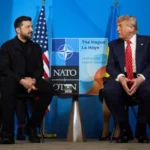A New Leverage in Cooperation: The Critical Minerals Agreement
The Trump administration has approved its first arms sale to Ukraine since Donald Trump took office. According to The Guardian, Washington has certified a license to export defense equipment and related services worth at least $50 million. This move signals a potential revival of weapons deliveries to Kyiv and coincides with the signing of a landmark critical minerals agreement—marking a breakthrough in U.S.-Ukrainian relations.
Ukrainian President Volodymyr Zelenskyy stated that the long-awaited minerals agreement, which he said turned out far more favorable for Ukraine than initially expected, was the result of his meeting with Trump during the Pope’s funeral. In his evening video address, Zelenskyy highlighted the symbolism: “Now we have the first result of the Vatican meeting, which makes it truly historic. We are awaiting other outcomes from that meeting.”
Zelenskyy described the deal as “truly equal” and emphasized that it opens “the opportunity for significant investment in Ukraine.” His adviser, Mykhailo Podolyak, noted that while the agreement does not explicitly mention any specific weaponry, it lays the groundwork for parallel negotiations on arms purchases. “The American side is now open to these discussions,” Podolyak said in an interview in Kyiv.
The agreement was signed in Washington by Ukraine’s First Deputy Prime Minister Yulia Svyrydenko and U.S. Treasury Secretary Scott Bessent. It envisions a joint investment fund to be financed through new licenses for the extraction of critical resources, including oil, gas, and rare earth minerals. U.S. officials stated that they expect the Ukrainian parliament to ratify the deal within a week.
Crucially, unlike previous drafts, the new agreement excludes any attempts to recover U.S. aid previously sent to Ukraine as humanitarian or military assistance—a position Trump had publicly advocated multiple times. The document also explicitly ensures that implementation must not obstruct Ukraine’s EU integration and that American companies will not receive monopolistic privileges in Ukraine but will instead be allowed to participate in open tenders on equal terms.
According to The Guardian, finalizing the document took around three months. The first draft, brought to Kyiv by Bessent, was rejected by Zelenskyy as excessively punitive. A planned signing ceremony in the White House in February collapsed after a heated Oval Office exchange, during which Trump and Senator JD Vance harshly criticized Zelenskyy and abruptly ended the meeting.
Washington Reopens the Door to Military Supplies
Nevertheless, Podolyak pointed out that the actual negotiations were far less confrontational than U.S. public statements suggested. “That’s the style of this administration—they’re very aggressive in communications. They leak the worst possible terms, but in reality, they negotiate normally, and you can achieve results,” he said. According to him, such tactics are used to strengthen the U.S. bargaining position.
Podolyak added that under the new arrangement, since arms deliveries would no longer be free aid but require payment, Ukraine would have to be more strategic in selecting its purchases. “We’ll quickly identify which weapon types are critical and focus on those. For example, if we can produce our own drones, we’ll do that here. But there are some types of weapons that only the U.S. produces, with no alternatives,” he said.
As The Guardian previously reported, Zelenskyy has expressed interest in purchasing American Patriot air defense systems for tens of billions of dollars. Such purchases could be funded either by European allies or through the newly created minerals fund.
At this stage, it remains unclear what specific equipment or services are included in the proposed $50 million deal. Under the U.S. Arms Export Control Act, the State Department must notify Congress of any major arms sales. In this case, authorization was sought for a “direct commercial sale,” in which U.S. industry directly transfers defense articles or services to a foreign buyer under a State Department-issued license. The planned sale was first reported by Ukraine’s Kyiv Post.
The last major military aid package to Ukraine came under the Biden administration, when Congress authorized $1 billion in expedited support ahead of Trump taking office.
Moscow’s Reaction and Kyiv’s Strategic Reorientation
Russia’s response to the new agreement has been muted, except for a harsh comment from former President Dmitry Medvedev, who called the deal a disaster for Kyiv. “Trump has pressured the Kyiv regime to the point that they’ll have to pay for American aid with their mineral resources,” he wrote on Telegram. “Now [the Ukrainians] will be paying for weapons with the national wealth of a vanishing country.”
It appears the Trump administration is betting on a new model of cooperation with Ukraine—not through free assistance, but via commercial and investment-based agreements that formally respect the interests of both sides. As The Guardian notes, while the deal may seem like a compromise, it opens real prospects for the resumption of U.S.-Ukrainian military and technical collaboration.
This article was prepared based on materials published by The Guardian. The author does not claim authorship of the original text but presents their interpretation of the content for informational purposes.
The original article can be found at the following link: The Guardian.
All rights to the original text belong to The Guardian.




















